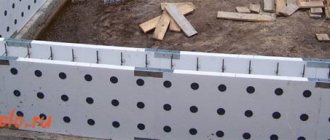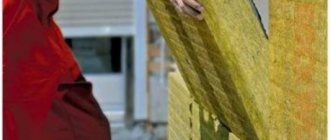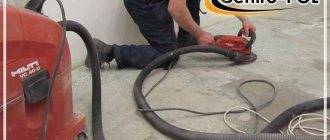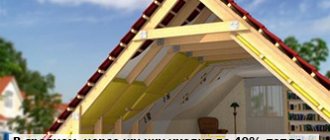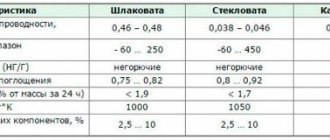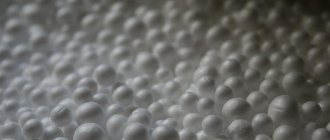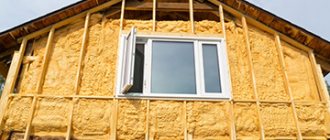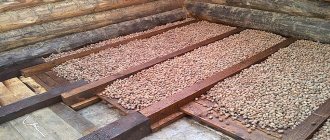Why and why is it necessary?
to insulate a columnar foundation for two purposes:
- protection of the foundation from thermodynamic damage;
- reducing the overall heat loss of the building.
If you leave the underground space uninsulated, the soil under the house will freeze.
In a protected basement, even in the most severe frosts, the ground temperature does not drop below 0°C.
Thanks to this, not only the energy efficiency of the house increases, but also the correct design of the foundation and the structure itself is maintained, since the soil does not swell during seasonal temperature changes, and the columns do not “walk.”
Reference! Insulation prevents the formation of condensation on buried structures and ceilings, which reduces the spread of rot and mold.
Insulation is of particular importance for those owners who have installed water supply in the basement of the house. At negative temperatures and insufficient insulation of the columnar foundation, the system will defrost.
Among other things, as soon as the construction of the house frame begins, the incompleteness of the base becomes obvious due to the presence of gaps between the supports. This also requires collection equipment.
As a result
Basically, how and with what to insulate the foundation depends on the personal preferences of the home owner, as well as his financial capabilities. Some will prefer to entrust all the work to specialized teams, while others will be able to complete the installation themselves.
And at the same time, it is not known in which version the result will be better. Specialists, of course, are good, but if you do it for yourself, then you will have a serious approach to your work!
Most houses built on stilts or columnar foundations are warmer due to the large air cushion between the foundation slabs and the ground. The open space is well ventilated, which ensures a minimum level of moisture. But in cold weather, concrete, stone or steel supports are in an extremely unfavorable position, so it is better to insulate them.
Why is it necessary to insulate a columnar foundation?
Insulating the floor on a columnar foundation and, as a consequence, reducing the heating of the pile material due to heat loss from the basement floor slab structures, and at the same time the strong cooling of parts protruding above the ground by frosty air can contribute to the emergence of a critical situation for the stability of the entire building. Reinforced concrete, and even more so steel screw piles, remove heat from the soil very well, thereby contributing to soil heaving. You can avoid such problems if you take a few additional measures and insulate the columnar foundation:
- Isolate the space under the house from any drafts and external frosty air;
- Install thermal insulation coatings on the surface of the columnar foundation supports;
- Insulate the soil adjacent to the buried part of the piles or pillars.
Important! It would be most rational to insulate the supports of a columnar foundation at the stage of installing piles in the ground.
Indoor and outdoor - various installation options
Installing thermal insulation from the outside has a lot of advantages:
- external thermal insulation will preserve the strength characteristics of concrete;
- regardless of the type of insulation, the cold will not penetrate into the basement and the building itself;
- external thermal insulation prevents the penetration of groundwater, helps waterproofing in protecting pillars from moisture, including condensation;
- the foundation, insulated from the outside, will be protected from humidity and temperature changes.
The option of internal installation is used less frequently , since in this case the thermal insulation will have more negative qualities than advantages.
If the house has a basement, thermal insulation inside will prevent the formation of condensation and create a comfortable microclimate.
The disadvantages include more serious factors - the outside of the foundation part will be defenseless against low temperatures. Temperature changes cause heaving of the soil, and this entails deformation and damage to the base.
How to insulate the blind area of a strip foundation
It is worthwhile to insulate the blind area under any circumstances, especially if the building stands on heaving soil or when installing a shallow foundation. Insulation for the blind area is selected based on the characteristics of strength, moisture resistance and durability. This can be expanded clay, extruded polystyrene foam or polystyrene foam. Let's look at how to make a blind area around the house from these materials.
Photo. Installation of an insulated blind area at home
How to calculate the thickness of the insulation, what layer to lay thermal insulation under the blind area, should be decided based on the depth of soil freezing in your region, the type of soil on the site and the depth of the foundation. In this case, the width of the blind area of the house will depend on the width of the overhang of the roof of the house. The blind area should be at least 200 mm further from the base of the house than the roof overhang. It is also necessary to observe the minimum slope of the blind area for water drainage.
Structurally, a traditional blind area with insulation, like the backfill of a house, consists of a cushion of sand and crushed stone, then waterproofing material (roofing material) and the insulation itself are laid on the bedding. For strip shallow foundations, the basement of the house and the blind area of the foundation are insulated at the same time. This work will allow you to insulate the basement and reduce the cost of heating the house in winter.
Materials for work
There are several types of thermal insulation materials. They all differ in thermal conductivity, density, flammability, water resistance and cost.
Styrofoam
Foam plastic is foamed plastic masses. Foam properties:
- Coefficient of thermal conductivity. Polystyrene foam is characterized by very low thermal conductivity. It can be used at temperatures from -50 to +75 degrees.
- Vapor permeability, water absorption, humidity. Even when completely immersed in water, the foam absorbs an extremely small amount of it. Therefore, this insulation is excellent for thermal insulation of foundations.
- Fire resistance. Polystyrene foam belongs to flammability class 3-4. The spontaneous combustion temperature is +491°C. These characteristics are 1.8 times higher than wood (+260°C) and 2.1 times higher than paper (+230°C).
- Resistance to adverse factors. Polystyrene foam is not affected by bacteria and other pathogens. But it is susceptible to destruction by rodents and termites. Direct UV rays, some types of varnishes and solvents (for example, acetone, benzene) also have a negative effect on foam.
- Strength and density. With a sufficiently low density, the foam has fairly high compressive and tensile strength.
- Environmental Safety. Polystyrene foam is a neutral material. During operation, it does not emit toxic substances that are harmful to human health.
- Cost about 100 rubles. for 1 sq. m.
Attention! Polystyrene foam is more suitable for internal insulation of a columnar bathhouse foundation, because... this material has a low density and cannot withstand intense mechanical loads. However, many builders use this material for external thermal insulation due to its low cost.
Penoplex
Penoplex is extruded polystyrene foam (foam plastic). Properties of penoplex:
Coefficient of thermal conductivity. Small compared to many other materials. Its value is 0.03 W*m*0С. This is higher than that of polystyrene foam, but 9 times lower than, for example, Rockwool mineral wool. Temperature range for normal operation is from -100 to +75 degrees.- Water absorption, humidity . Water absorption is minimal. Moisture can only penetrate into the outer cells of the penoplex, which were damaged when cutting the insulation. Water cannot penetrate inside closed cells.
- Vapor permeability is low. The material is characterized by increased resistance to moisture evaporation. A layer of slabs made of this insulation 2 cm thick is equal to a layer of roofing felt.
- Fire resistance. Penoplex is a non-flammable material if the combustion process is natural and active. But this material is capable of melting under high temperatures.
- Resistance to adverse factors. Penoplex is not subject to rotting and decomposition, and mold fungi do not develop in it. This indicates the high biostability of the insulation. Rodents don't eat it either, but use it for their nests.
- Strength and density. When compressed, it is very resistant. Evenly distributed cells improve the strength characteristics of the material.
- Environmental Safety. Environmental friendliness is at a high level. Chemical activity is practically zero.
- Cost about 300 rub. for 1 sq. m.
Reference! The advantages of Penoplex include the ability to insulate foundations without using an additional moisture-proof layer, because the material practically does not absorb water. This insulation is also easy to use and durable. This material is optimal in price and quality for columnar foundations.
Polyurethane foam
Polyurethane foam is a foamed type of plastic. Properties of polyurethane foam:
- Coefficient of thermal conductivity. In thermal conductivity it is second only to aerogels. On average, the coefficient is 0.028 W/(m*degC).
Water absorption, humidity. Moisture permeability no more than 1%. This foam accumulates more moisture than EPS, but less than other thermal insulators.- Fire resistance. Fire hazard degree from G1 to G4. Depends on the use of fire-resistant impregnations. It is important to know that impregnations reduce the energy efficiency and service life of the material.
- Resistance to adverse factors. Sufficiently resistant to chemicals, in particular solvents, acids, alkalis. Rodents do not eat foam, but they can nest. The insulation is resistant to mold formation. Polyurethane foam requires protection from UV radiation; it is not recommended to keep it for more than 4 days without shelter.
- Strength and density. Compressive strength up to 120 - 150 kPa. Identical to medium density foam brands. Density is about 30kg/m3.
- Environmental Safety. The material is safe and non-toxic. After applying polyurethane foam, no harmful substances are detected in the room.
- Cost 429 - 450 rub. for 1 sq. m.
Polyurethane foam is characterized by ease and speed of application, high strength and low water absorption.
It retains its properties even in wet soil. It can be used not only for thermal insulation of the foundation, but also for insulating the perimeter of the building. Suitable for all types of brick and wood buildings. It is superior in cost to other types of insulation.
Mineral wool
Mineral wool is a loose material consisting of randomly woven fibers. Material properties:
- The thermal conductivity coefficient is 0.048 W/(m*C).
- Vapor permeability. Cotton wool allows air and steam to pass through well. Free steam and air exchange occurs, which prevents the formation of condensation and mold.
Water absorption, humidity. It tends to absorb moisture, so it requires the addition of a waterproofing layer.- Fire resistance. Absolutely non-flammable and fireproof. Not exposed to open fire. This is especially important for wooden buildings.
- Resistance to adverse factors. Not subject to temperature changes. Cotton wool is made on a synthetic basis - it is not afraid of rodents, fungi, or other microorganisms.
- Strength and density. Not subject to shrinkage and deformation even after many years of use.
- Environmental Safety. Mineral wool contains phenol formaldehyde. But when the manufacturer follows the production rules, no harmful substances are released, or they are released in a minimal amount that is not capable of causing harm to health. However, the instructions indicate recommendations for working with this material (glasses, respirators, closed clothing).
- The cost depends on the number of sheets in the package and the type of mineral wool. The material is included in the average price category of insulation.
Attention! Mineral wool does not like moisture, so it requires protection from moisture with additional materials. Its installation is quite labor-intensive. It is most often used to insulate the floor in a house on a columnar foundation from the inside.
Expanded clay
Expanded clay is a lightweight porous material obtained by firing clay. Material properties:
- Coefficient of thermal conductivity. The indicator varies from 0.14 to 0.92 W/m*C.
- Water absorption, humidity. The coefficient compared to other insulation materials is quite low - about 15%.
- Vapor permeability. The structure is protected from excess moisture, because the material is vapor permeable. The indicators are 0.09–0.3 mg/(m*h*Pa) depending on the amount of expanded clay in the blocks.
Resistance to temperature fluctuations, fire resistance. The material is resistant to open fire and temperature changes. The melting point is in the range of 1200-1250°C, less often – 1300°C. Frost resistance of at least 25 cycles.- Resistance to adverse factors. Not susceptible to mold and rot. Rodents, insects and other pests also do not show interest in expanded clay.
- Strength and density. Density on average from 500 kg/m3 to 1800 kg/m3. Expanded clay does not change its properties over time and retains its original characteristics if backfilling was carried out according to the rules. Environmental Safety. This is a completely natural material, which ensures safety for the soil and foundation. Does not react with anything and does not emit harmful substances.
- The cost is within 150 rubles. for 20 kg.
Expanded clay is an inexpensive natural insulation material. It can be used to protect strip foundations from freezing, but is more often used for floor insulation.
It is important to know that expanded clay must be dry when filling. For insulation of columnar foundations, expanded clay is rarely used or not used at all due to the inconvenience of installation and low thermal conductivity.
How can you insulate?
It is quite easy to insulate a columnar foundation from the outside with your own hands - you do not need any construction education or special skills for this.
First of all, you need to decide what raw materials to use for thermal insulation of the foundation.
One of the most rarely used materials for insulating columnar foundations is mineral wool.
It is sold in tiles and rolls and has a good thermal conductivity coefficient.
Its main disadvantage is its high water absorption, therefore, along with mineral wool, you must install waterproofing and vapor barrier yourself, otherwise the columnar foundation of the house will be practically unprotected from moisture.
A fairly cheap, but not the best material is polystyrene foam. Its use can save a significant amount of money, but it is considered very unstable to moisture and has poor strength.
Expanded clay is considered a time-tested raw material. For such insulation of a columnar foundation, it is necessary to build formwork from boards around the perimeter of the house, and then fill it with expanded clay to a depth of thirty to forty centimeters. Its disadvantage is its increased vulnerability to moisture.
Extruded polystyrene foam is considered a good material for insulating a columnar foundation.
It is highly durable, resistant to moisture, retains heat well and is not afraid of rodents. The only downside is the price.
The most modern material for insulating columnar foundations is polyurethane foam.
It has all the necessary characteristics for excellent insulation of a house; it is easy to apply it to the foundation with your own hands. The speed of work is quite high, which is also an advantage.
However, it must be taken into account that polyurethane foam is applied to the foundation using a special blowing machine.
If you can’t rent it, then you won’t be able to do the work yourself: you will need to call representatives of some construction company.
Most home owners prefer to insulate the foundation with penoplex, a material made from extruded polystyrene foam using a special technology.
How to insulate with your own hands?
The insulation of the support-column foundation of both brick and wooden buildings is carried out using the same technology. The main thing is to adhere to the work algorithm and take into account the requirements for materials.
Pickup device
The fence is a wall between the foundation supports that insulates the basement space and protects it from dust and precipitation.
Its full insulation allows you to rid the building of drafts, provides a good microclimate and the absence of humidity.
Step-by-step instruction:
Between the supports you need to dig holes 20 - 40 cm deep.- Make a gravel-sand cushion - fill 1/3 of the gravel and sand into the holes.
- Then construct a sheathing from the bars:
- with the vertical type of fastening of the bars, one part is fixed in the pit, and the other in the lower part of the building;
- with horizontal fastening, the bars are attached directly to the posts;
- You need to insert boards (their thickness is 4 - 6 cm) into the grooves of the bars and carefully secure them.
- After this, you can proceed to arranging thermal insulation.
Features of working with foam plastic
Working with polystyrene foam is quite simple:
- first you need to clean the surface of the insulation from debris and construction dust;
- then remove the unevenness and seal the existing cracks;
- the insulation must be fastened from the bottom up;
- glue must be applied to the slabs;
- then glue the slabs to the sheathing and secure with plastic dowels;
- then install the reinforcing mesh and putty;
- apply facade plaster.
Features of penoplex insulation
Installation is also easy:
apply a special adhesive mastic to the entire surface: from the sole to the grillage;- Press the slabs against the wall to the zero level;
- between the zero level and the grillage, secure the penoplex with umbrella dowels;
- to secure heat-resistant dowels, drill holes in the base;
- the panels are joined groove to groove - check the seams; To be sure, insulate them with polyurethane foam.
Thermal insulation with polyurethane foam
You can do all the work yourself if you rent a blowing machine:
- clean the entire foundation of dust particles, debris, and traces of soil;
- Apply foam to the base - it will fill all the cracks, voids, air pockets and uneven areas.
The foam has excellent adhesion. The material quickly sets on surfaces, resulting in a synthetic board of high strength.
Reference! Polyurethane foam does not absorb moisture. Experts recommend laying waterproofing made of a water-repellent material, for example, liquid rubber, polyurea and others, on top of the insulation layer.
It will not be possible to completely foam the foundation manually. If you can’t get a car, you will have to contact the company’s specialists.
Insulation using penoplex
Penoplex insulation is by far the most affordable and optimal option.
The material has many advantages - it is very strong and durable, resistant to prolonged exposure to moisture and low temperatures, retains heat well, and does not harbor rodents, various insects and microorganisms.
At the same time, it is environmentally friendly and safe for humans.
Penoplex slabs are available in a variety of thicknesses - from twenty millimeters to a meter. This allows you to purchase the required material of the required thickness and not pay extra money for what is unnecessary.
In addition, there are three types of insulation with different densities and different sizes, which gives a greater choice based on the wishes of the client.
At the same time, it should be noted that penoplex insulation can be easily done with your own hands, which also allows you to save money.
The only drawback of this material is its high flammability. This can be corrected by applying a fire retardant (a special component that provides fire protection), but it must be remembered that it is harmful to health, so its use requires caution.
To insulate a columnar foundation with penoplex, sheets of this material are attached to the foundation either using special glue or dowels.
The base is pre-cleaned of dust and dirt for better adhesion (adhesion) of surfaces.
If installation is carried out using dowels, it is recommended to sheathe and connect the pillars with boards to create a frame for attaching heat-insulating boards.
It is necessary to ensure that the gaps between the foam sheets are minimal - after the fastening is completed, it is recommended to fill them with polyurethane foam.
If necessary, waterproofing is installed outside the house for greater protection from moisture.
After work, the sheets themselves are plastered and covered with PVC panels or siding - this is necessary to protect the penoplex from sunlight and mechanical damage. When exposed to the sun, this material begins to deteriorate.
Penoplex insulation of a columnar foundation is considered the optimal solution both in terms of labor costs and financial cost.
Due to its characteristics, this material is one of the best for insulation and can be easily installed with your own hands, even without any construction skills.
Insulating a house with a columnar foundation allows you not only to increase comfort, but also to extend the life of the foundation of the building.
Therefore, this issue must be approached as responsibly and thoughtfully as possible, choosing the appropriate material for the work.
One of the final stages of finishing an already constructed building is the thermal insulation of its foundation, as this ensures comfortable conditions in the house. In solid foundations, the issue of their thermal insulation is easily resolved, but in columnar foundations, this causes additional problems and work.
Insulating a columnar foundation with a back-up device is the easiest way to solve this problem. What is pick-up and how it is done, we will consider below.
Types of fences for insulating a columnar foundation
The fence is one of the options for the base, which is an accessory to columnar foundations and performs the function of protecting the space between the building and the ground from rain, snow and wind.
A variety of materials are used for scaffolding, affecting its structural design and construction technology. Let's decide on all these parameters for each specific option:
Wooden pick-ups. This option, in turn, has several subtypes, namely: made from boards, with vertical or horizontal installation of the latter, and made from logs or timber.
When making a fence with horizontal boards, installation is performed as follows:
- a trench 200-400 mm deep is dug between the pillars;
- sand and fine gravel are poured to approximately one-third of the depth;
- bars or logs with a groove are attached to the posts;
- boards 40-60 mm thick are inserted into the grooves, with the bottom board resting on a cushion in the trench;
- then the lower part, from the inside, is covered with expanded clay or other heat-insulating backfill.
When installing boards vertically in a recess, a log with a groove is placed in a trench made according to the previous option, a second, identical log is attached to the bottom of the building, after which the boards are vertically inserted into the grooves.
In some cases, logs are laid horizontally between the pillars, similar to the construction of a log house.
Fences made by masonry of brick, stone, etc. In the case of constructing a fence from these materials, a trench with a cushion is also required, which is the base for its walls. When made from stone, the thickness of the wall is made within 300 mm; from brick, it is placed in 1-1.5 bricks.
The fences are insulated with heat-insulating sheets. In buildings installed on high poles (from 0.7 m and above), insulation of the underground space is carried out in this way:
- a frame structure made of steel profiles of various sections is attached to the posts;
- from the inside, sheets of polystyrene foam, expanded polystyrene or other heat-insulating material are hung on the frame;
- from the outside, with self-tapping screws, corrugated sheets are attached;
- the gap between the corrugated sheets and the ground, on the inside, is covered with heat-insulating material.
For all options for making a fence, ventilation holes must be left in the opposite walls, 100-150 mm in diameter is sufficient. For the winter, these holes are closed with plugs.
Which of the presented options for insulating a columnar foundation is better and which one to choose can only be decided by the home owner himself.
Insulation of a columnar foundation - insulation technology
Insulation of a columnar foundation One of the final stages of finishing an already constructed building is the thermal insulation of its foundation, as this ensures comfortable conditions in the house. In continuous
Insulating a columnar foundation with your own hands is a reliable way to protect the foundation from the effects of physical factors. By doing everything yourself, you can make it even more economical, and also make sure that everything is done conscientiously. At the same time, heat losses are reduced by approximately 1/5, and the period during which a private house will be operated without problems increases significantly.
Basically, the insulation of a columnar foundation is not fundamentally different from the insulation of other types of foundations.
So, what should you do before you start insulating the foundation?
- Find out with the help of a local geological survey service how deep the soil freezes where the house is located (after all, the foundation will be insulated to this level).
- Choose the insulation method (internal or external).
- Choose how to insulate the columnar foundation of a house.
- Carry out preparatory work before installing the thermal insulation layer on the outside.
- Install fences that compensate for the distance between the foundation supports and protect against water getting inside.
- Find out whether preliminary waterproofing is required.
Possible mistakes
After the construction of the fence, the columnar foundation becomes closed.
If you do not provide for vents in advance, you will have to install them, disrupting the entire installed structure. It is important to choose dry insulation , especially for more permeable materials (such as mineral wool or expanded clay). Otherwise, the insulation will pick up moisture even faster and will have to be replaced.
Attention should be paid to the control of insects and rodents. Most modern materials are not to the taste of living creatures, but they are excellent as nests. Special preparations and equipment will help in the fight against this scourge, as well as careful insulation, making access to the insulation inaccessible.
Attention! During installation, it is better to pre-treat the materials adjacent to the insulation with fire-fighting and antifungal impregnations. This will provide protection from possible fire and rot.
Why do you need base thermal insulation?
Insulation of the foundation of a wooden house can be internal and external. In any case, thermal insulation will help prevent many of the destructive factors.
External insulation (regardless of material) protects against freezing and cold air entering living rooms, allowing you to save approximately 1/3 of electricity. In addition, the foundation, insulated from the outside, is protected from the destructive effects of moisture from the soil, which extends the life of communications and the very foundation of the building.
Arranging thermal protection from the inside contributes to the formation of an optimal microclimate in the basement and, accordingly, in the house, creates an obstacle to the penetration of groundwater and the accumulation of condensation, which eliminates the appearance of mold.
Insulation of a columnar foundation
The methods described above are applicable for monolithic and strip foundations, but they are not suitable for columnar foundations. To ensure thermal insulation of the space between the soil and the grillage, it will be necessary to create a special fence. This element is functionally similar to the plinth, but since it is not loaded, the requirements for structural strength are significantly lower. Sequence of work:
- A 50-centimeter trench is dug in the spaces between the foundation pillars, a third of its volume is filled with a sand-crushed stone mixture;
- A metal frame is laid on the pillow, on top of which concrete mortar is poured;
- Solid brickwork is installed on the hardened concrete, leaving small ventilation holes.
Properties of polymer insulation
In modern construction, the most suitable polymer materials are used to carry out foundation insulation work:
- penoplex;
- extruded polystyrene foam.
There are no fundamental differences between these polymer-type heat-insulating materials. This is explained by the fact that they are made on the basis of polystyrene. There are minor differences in the production technology of these heat insulators related to foaming. Penoplex and extruded polystyrene foam for the foundation have properties such as low thermal conductivity and high strength. These heat insulators are excellent for insulating the foundation of a cottage or private house. With their help, you can insulate columnar, shallow, strip, pile and other types of foundations.
The materials are similar in composition, which is reflected in their durability and quality. They do not absorb water, but polystyrene foam, which has lower thermal conductivity than polystyrene foam, is more durable.
The cost of expanded polystyrene is higher than that of polystyrene foam. Consequently, prices for insulation with these materials vary. These heat insulators have an attractive appearance. According to some information circulating among builders, foam plastic is considered a material that can replace 50 cm of brickwork. No one has conducted any experiments to compare the density of brick and foam plastic, but this indicator is lower for PPS, so the insulation has less thermal conductivity than brick.
Step by step guide
It is advisable to carry out thermal insulation at the construction stage, this will eliminate the labor-intensive stage of excavation work. The technology of the process depends on the type of foundation, but it is advisable to place pieces of Penoplex under columnar, pile or strip structures only at the construction stage; this method is recommended for high groundwater levels. The slabs are also attached to the basement or foundation walls (vertically), this option allows you to reduce possible heat loss through the bottom of the building to 15-20%. The edge of the Penoplex protrudes at least 40 cm above the ground level and 30-40 down; to eliminate deformations on heaving soils, the scheme is reinforced with a perpendicularly located piece of compacted foam with a thickness of 50 cm; in unheated buildings it is placed under the walls inside.
The main stages of traditional (vertical) insulation of foundation walls with your own hands using Penoplex slabs:
1. Calculation of the material, preparation of a diagram for placing the slabs (it can be easily processed, but it is not worth cutting it again).
2. Preparing the trench, backfilling with sand and gravel mixture, laying drainage pipes.
3. Leveling the walls with cement mortar.
4. Waterproofing of structures (a mandatory step when insulating the foundation).
5. Cutting Penoplex, attaching it to the walls. Glue or bitumen mastic is applied pointwise, the slab is pressed against the base with force for several seconds.
6. Installation of the second layer according to a checkerboard pattern; the same compounds are used for gluing.
7. Partial backfilling of insulation, it is recommended to replace part of the soil with coarse sand, organizing a blind area.
8. Laying reinforcing mesh and external cladding.
Main characteristics and advantages of penoplex boards
Penoplex is a board made of extruded polystyrene foam.
After much searching and experimentation, the ideal material was finally found that can be used as insulation. This is penoplex, supplied in the form of slabs 600 mm wide, 1200 mm long and 20-100 mm thick. The main feature of the material is its production method, which makes it possible to obtain a dense material that has a uniform structure, consisting of granules 0.1-0.2 mm in size, mixed by foaming polystyrene foam at high temperatures. At the same time, a foaming component from a mixture of freon and carbon is introduced into the penoplex composition. Thanks to this, penoplex has the following advantages that distinguish it from other heat insulators:
good thermal conductivity - regarding insulation, a very valuable argument is the low thermal conductivity index that penoplex slabs have; low degree of water absorption - tests showed that penoplex, which was immersed in water, gained moisture in a volume equal to only 0.6% of the total volume in 30 days
Here we can also note the low vapor permeability of the material and its resistance to rotting and biological decomposition; high compressive strength, which is very important given the large loads in this direction; the durability of penoplex, which has an unlimited validity period; ease of installation - foam boards are even easier to install than a children's construction set, and when insulating a shallow foundation, additional fastenings are not required at all; versatility - the material is used equally effectively both inside and outside buildings. In addition, penoplex for floors is as effective as slabs used for insulating walls and foundations; penoplex is environmentally friendly, since only natural ingredients are used for its production; Penoplex boards are fire-resistant and fireproof.
Considering the considered advantages, it is worth noting that penoplex insulation is simply necessary today. Especially if the question concerns foundation insulation. As you know, the foundation is designed to withstand the main loads, and danger threatens it from all sides. The previously used heat insulators coped with their task, but most of them themselves required protection from groundwater and wastewater. As for penoplex, a characteristic feature of the material is that it itself is capable of providing groundwater drainage, thereby reducing the pressure on the main elements of the building.
Calculation of quantity and selection of the “right” penoplex
If high-quality material is used for insulation work, you can count on a good result. By appearance, you can determine whether the material is suitable for insulating the support of a house.
To insulate the foundation, a special series “F” material is used. This type of insulation is more resistant to biological decomposition, mechanical stress and wetness.
The material is ideal for external insulation of the base, basement or basement, so when purchasing, be sure to pay attention to the marking
To simplify the process of selecting penoplex, you should pay attention to products from well-known manufacturers, which are used not only in the construction of private buildings, but also for insulating apartment buildings. Before purchasing polystyrene from any trade organization, you should correctly calculate the amount of material that will be used to insulate the foundation and basement of the house
Before purchasing polystyrene from any trade organization, you should correctly calculate the amount of material that will be used to insulate the foundation and basement of the house.
- To determine the area of insulation, it is necessary to measure the perimeter of the base, multiply the resulting value by the sum of the depth of the foundation and the height of the base.
- For example, if the perimeter of the building is 36 m, the depth is 1.5 and the height of the above-ground part of the base is 0.5 m, then 36 * (1.5 + 0.5) = 72 m2.
In this way, you can easily calculate the amount of penoplex that will be required for work.
